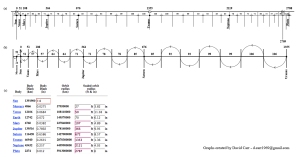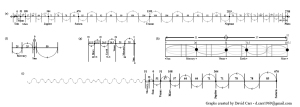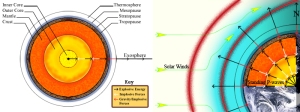By David Carr
4/20/14This is the result of further research using the distance of the planets from the Sun to explain the direction of gravitational waves and the fluctuation of their wavelengths. The graphs created are an example of how gravitational wavelengths can be measured by using the distance of each planet from the Sun. The node position for the waves can be determined by using a repeating pattern of expanding and contracting wavelengths. This research has yielded results which explain how gravitational waves are traveling both towards and away from the Sun creating standing waves and holding the planets in their position.
Measuring Gravitational Waves
The figures on all the graphs are scaled to the orbit radius of feet and inches when using the distances of the planets from the Sun see graph (c). These figures were calculated using http://www.exploratorium.edu/ronh/solar_system/ and can be observed by entering 7.874015 inches as the Suns body diameter. As most everything else in science the figures are not exact but are within a reasonable distance. According to calculation Mercury is off by 1/21 the distance between it and the Sun. As an example, if using US standard units for measuring this would be less than 1/16 of an inch compared to one inch of distance. Saturn is off by 1/225 of the distance between it and Sun while Neptune is off by 1/1060 of its distance.

Note: Because the waves travel in both directions some graphs are read from right to left using the Sun as the starting point. An example of this would be on graph (g). The North Pole is at the top of the Sun on all the graphs as seen in graph (b).
In graph (a) are the distances of Venus, Mars, Jupiter, Saturn, Uranus, Neptune and Pluto from the Sun. Starting at the Sun each set of wavelengths increase by 7. The first wavelength at the Sun is only 1 as seen in graph (f). The first of the largest wavelengths start at 50. The groups would count down and back up by adding 7 as they surround the Sun forming the disk shape of the solar system. Here is an example; 106, 106, 99, 99, 92, 92, 85, 85, 78, 78, 71, 71, 64, 64, 57, 57, 50, the Sun, 50, 57, 57, 64, 64, 71, 71, 78, 78, 85, 85, 92, 92, 99, 99, 106 and 106. When adding these groups together the distances for each planet are almost identical to the figures on graph (c).
Once the wavelengths reach Uranus the size of each group counts backwards until reaching Neptune at 2119 (e). At the distance of 2709 the wavelengths reach the original starting point of 50 (a). The numbers continue to count down by 7 only one group at a time until the distance of Pluto is reached (a). Here is an example; Uranus, 106, 106, 99, 99, 92, 92, 85, 85, Neptune, 78, 78, 71, 71, 64, 64, 57, 57, 50, 43, 36, Pluto.
Incoming and Outgoing Waves

In graph (e) the wavelengths can be visualized from the Sun to the distance of Pluto. Using the Doppler Effect as a reference, can the size of the wavelengths determine the direction they are traveling? By using this method the gravitational waves would be traveling back and forth just as standing waves in a lab pool (m-p). They are traveling from Uranus to the Sun and in the opposite direction from Uranus to Pluto (m). If this hypothesis were correct it’s possible the redshift of objects, which are seen using a radio telescope, may not be moving away from us but instead we are observing the waves travel into the objects at different frequencies.
As mentioned before graph (f) displays how the Sun has a smaller wavelength by the number 1. Mercury is on a smaller wavelength compared to the larger incoming wave. In graph (g) these waves appear to be traveling away from the Sun implying this is how the incoming wavelengths are altered once they reach the Sun. Graph (h) displays how the distances of the octaves and harmonics change as the groups of standing waves expand or contract.
Once the wavelengths reach the Sun the groups change in size by 5’s. By using the same pattern of counting down then back up the distances of all the inner planets can be matched up to the second wavelength (g) along with all of the outer planets. Because the waves which are traveling into the Sun are coming from all direction in a plain position the incoming waves (gravity) overlap the outgoing waves (solar winds) coming from the opposite direction. The two forces moving back and forth behave the same as standing waves (m-p). The matching node positions of the two waves hold each planet in their orbital position.

Graph (j) displays the outgoing wave pattern. Counting down in groups of 5 starting at 51 including the 1 for the Sun the pattern would look like; Sun, 1, 25, Mercury, 25, Venus, 20.5, Earth, 20.5, 15.5, Mars, 15.5, 15.5, 15.5, 20.5, 20.5, 25.5, 25.5, 25.5, 25.5, 20.5, 20.5, 15.5, 10.5, Jupiter, 10.5, 15.5, 20.5, 20.5, 25.5, 25.5, 25.5, 25.5, 20.5, 20.5, 15.5, 15.5, 15.5, 15.5, 20.5, 20.5 and Saturn. The area between the Sun and Jupiter is broken up into three groups of waves (see the arrows in graph j). The first is outgoing waves located between the Sun and Mars, the second is incoming located at the asteroid belt and the third group ends at Jupiter. When the wave reaches Jupiter the numbers count down in single groups by 5 until it is reached than counts back up using the same pattern. After the sixth group the waves located at Saturn, all six groups combined repeat but in the opposite direction until the waves reach Uranus as seen in graph (k). In graph (l) the same group of six waves continue four times starting forward than backwards than forward and finally backwards one last time before reaching the 2708 position. At this point the wave begins to fade out. Each area counts down by fives until it reaches 5.5 when it is then divided in half (l). This is the position of Pluto which is at 2788. Notice the incoming wave begins at the 2709 mark (a) indicating both wave patterns reach the same distance.
When comparing graph (a) with graph (l) the distances of each planet from the Sun are almost an exact match. Mars is off by .5, Saturn is off by 1, Uranus is off by 1 and Neptune is off by .5. Venus, Jupiter and Pluto are exactly on the number. This shows the two patterns have node positions which are overlapping at the same distance the planets in the solar system are located. These two forces can be used to explain what determines the position of the planets.
It seems the wavelengths can be broken down even further. Using 3, 3, 6, 6, 9, 9, 6, 6, 3, 3… etc. The numbers once again closely resemble the same pattern as the planets distance in graph (c). This wave has node positions at 27, 51, 108, 363, 675, 1356, 2118 and 2787. These numbers are almost a perfect match to graph (a, l). Although Earth’s distance didn’t align with the pattern its exactly in-between the two numbers which are before and after. The halfway point between 66 and 75 is 70.5 which is the exact distance to graph (j).
Note: The standing waves which create these orbital positions may vary in wavelength size depending on the position of the planet in its orbit. Here is an example, the wavelengths which determine Pluto’s position may be much shorter on one side of the Sun than on the other. This would result in an elliptical orbit.
Frequencies

Graphs (m-p) display the standing waves as they would appear in a repeating cycle. Starting at (m) and ending at (p) the sequence repeats at a high rate of speed. When the two waves, traveling into one another, reach Saturn they overlap at the same distance (n). They travel away from each other with Uranus as the center point (m). Once the waves overlap there would be an empty space between Saturn (n) and the 2031 position seen in graph (l). As the waves continue in both directions the Sun would eventually be at the center of an empty space (p).

When the waves strike the Sun they create a cycle of explosions. This creates pressure waves in the form of P-waves which determines the layers of the Sun while S-waves or gravitational waves travel back into space holding the planets in their positions. When the waves enter the Suns core they create an implosive force known as gravity (m). As they leave the Sun’s core they create explosive energy which isn’t as strong as the incoming gravitational force (n). The implosive and explosive energy occurs on a certain frequency. Here is an example, when turning a light on and off at a very high speed the frequency would be determined by how many times the light is on in a certain amount of time. Using the switch as an example this idea can explain dark matter. Imagine the Sun turning on and off at an extremely high rate of speed. If the Sun’s “light switch” is on (m, n) while a distant star is off (o, p) the light from the distant star would not be visible. This would imply the Sun is on the opposite frequency as the areas considered dark matter. Another example on a larger scale is blinking Christmas tree lights. Imagine if they could blink so quickly that the human eye wouldn’t see the darkness in-between. When attaching two different cords to each other some lights blink on while another group of lights are off. Imagine the lit group of lights as the stars visible to each other while the second group which is off would be the dark matter. The two groups of lights would be on opposite frequencies. This would mean we are dark matter to another part of space.
The inner-planets would be on a higher frequency then the Sun. When the incoming waves strike the Sun (m) its core would have one sustained explosion while at the same time the inner-planets would have three (see arrows in j). This would signify that the Earth would experience three explosions before fading out with the Sun (o, p). Notice Earth and Mercury are the only planets to be held in place by the higher frequency waves which are only outgoing.
Why wouldn’t we see the Sun while its light is out? The human body functions from an energy source which is supplied by the Earth. The Earth gets its energy from the Sun, if the Sun is basically in the off position so would every living and mechanical thing which depends on its energy. Could these other frequencies that are not seen be considered different dimensions?
Just as the temples and monuments of the ancient world mankind should build our destiny one stone at a time. Thank you for reading.
No comments:
Post a Comment